So empty, Big Sadge :(
Diablo 4 Gems Farming Boost
Gems in Diablo 4 are part of character progression, allowing you to socket them into your gear to gain bonus effects, enhancing your character’s abilities and stats. For instance, gems grant damage to your weapons, defensive stats to your armor, and resistances to your jewelry. The potential for customization and power growth is immense, making gem farming an essential part of the Diablo 4 experience.
However, obtaining and upgrading these gems requires a significant amount of time and effort. This is where our Diablo 4 Gems Farming Boost service comes in. Our dedicated players will invest their time and effort to farm any amount of gems for you, allowing you to focus on enjoying the game. Whether you’re looking to enhance your weapon’s damage, boost your armor’s defensive stats, or increase your jewelry’s resistances, we’ve got you covered. Don’t spend countless hours grinding — let us do the hard work for you. Choose our Diablo 4 Gems Farming Boost service today and experience the full potential of your character!
Service Includes
- A desired amount of Gems of a chosen type:
- Royal gems;
- Grand gems (the best ones);
- Amethyst, Diamond, Emerald, Ruby, Skull, Sapphire, and Topaz gems included;
- All the gold expenses covered.
This boost will be completed in ![]() Self-Play mode.
Self-Play mode.
Delivery Info
Estimated Start Time: 15–20 minutes;
Estimated Completion Time: 15 minutes.
Additional Options
Unlock Torment IV Difficulty — we’ll unlock the Torment IV game difficulty by finishing Tier 65 of the Pit of Artificers and improving your Glyph levels even more!
Add 1 billion Gold — this extra option will provide you with this huge heap of gold we farmed for you, at a low cost! Gems are not the only matter you have to grind for to gain effects increasing your character’s capabilities. Gold changes a lot for you, too, especially if you want to reroll those nasty affixes to fine tune your character build. Gain enough resources for that with our Gold additional option!
Stream — if you want to look at our professional booster working at getting those gems for your equipment, you can select a Stream option, which means you’ll get a link to a YouTube or Twitch stream!
Requirements
No specific requirements are present.
How It Works
So, when you finally decide to get help from our team for the Diablo 4 Gems Farming boost, you’ll need to pass through some simple steps:
- Choose the most suitable options for the Diablo 4 Gems Farming Carry, like your platform and realm, as well as the type and number of gems you want for your character type, and once the purchase is done, wait for our service agent to contact you in 3 to 7 minutes to discuss any of your questions and the Diablo 4 Gem Farming boosting service date;
- Stay on the line until our professional booster gathers all the required materials for our task and sends all the necessary gems your way!
- This service is provided in Self-play mode (no need for the Piloted mode) since gems can be traded in Diablo 4. We’ll be in touch with you on our quality service progress. Don’t worry about the quests that give you gem caches or other loot-gathering stuff — with our site and quality Diablo 4 Gem Farming Service, you will be sure to get those gems for your gear (armor, weapons, and jewelry) and finally visit your local Jeweler with full hands!
- Finally, reap all the benefits after approximately 30 minutes per Grand gem (and less for other types) and go add sockets into your gear slots if you don’t have them yet, since after Diablo 4 Gems Farming Boost, you’ll need a lot of slots in each armor piece as well as jewelry and weapons!
- Share your effortless completion experience by leaving a customer review on Trustpilot to show the world how the Diablo 4 Gems Farming service went.
That would be it for unlocking the full potential for the character on your account! After all the desired materials gathered and the grind task complete, please be welcome to sample other helpful Diablo 4 services on our website to skip tedious farm and get new gear, rewards, or cosmetics for your account! Note that we employ Remote Control options for those services as well, so there’ll be no need for us to log into your game account even for the most complex tasks! Till next time!
Frequently Asked Questions
What’s the difference between Flawless Gems, Royal Gems, and Grand Gems in Diablo 4?
The difference between gem types in Diablo 4, like a Royal gem, Flawless gem, or a Grand gem added in the Vessel of Hatred expansion, is their power. Basically, what you see here are tiers of gems available in Diablo 4: Emerald, Topaz, Ruby, Diamond, Amethyst, Sapphire, and Skull.
Flawless gems are the weakest of the three tiers — you can farm only 1000 gem fragments (the crafting material for all gems) of a certain type and craft your Flawless gem to socket in into any of the gear slots and increase your character’s capabilities at a Jeweler. Royal gem is a stronger version requiring you to obtain 10,000 gem fragments of a certain type this time, which is a much more tiresome farm process.
But the most powerful tier of gems is the Grand gem type you can obtain by the farm of a whopping number of 100,000 gem fragments and spending a lot of gold on it. This is something you’d most surely want to skip with our complete Diablo 4 Gems Farm Service — a very helpful way to make any customer happy!
What do the gems do once you craft gems and socket them?
The gems are needed to provide the positive bonuses to your gear. Here’s a small review of gems in Diablo 4. Aside from differences in gem power, all the gems in Diablo 4 are differentiated by their type, each one with its own sets of bonuses: Amethyst, Diamond, Sapphire, Emerald, Topaz, Ruby, and Skull (yep, the last one is not a gem per se but it fully counts as one in the game). Gems can be socketed into your gear at the Jeweler and are helpful for providing buffs like general damage resistance or your resistance to specific damage types.
You cannot insert a gem into Gloves and Boots, but you can insert two gems at once into your Chest, Two-Handed Weapon, and Pants gear pieces. Other gear allows for inserting one gem at a time. If you don’t have a socket, visit your Jeweler again and create a socket with some gold and the Scattered Prism resource.
Each gear type (Armor, Weapons, or Jewelry) has different benefits from a single type of gem. Say, Diamond can increase your general damage reduction (or, more correctly, gives you resistance to all elements) if inserted into Jewelry, but if you put it into your Armor, it will increase all your stats instead. And in weapons, you can expect it to boost your Ultimate damage. The same goes for other gems, but those like Amethyst, Topaz, Ruby, and Sapphire are focused more on specific damage types.
Is the price match option available for the Diablo 4 Gems Farming Boost?
Yes, we match prices if the service provider you saw offering the Diablo 4 Royal Gems Farming Carry at a lower price is not a scam, so please check if they are reliable. Otherwise, we won’t be able to do a price match, unfortunately. It would be helpful to see if they are credible by checking their Trustpilot or Reviews.io profile for some good customer feedback and many a review. But the full potential of the Diablo 4 Gems Farming Boost can be unlocked with Epiccarry, as we’re a trusted, credible, and experienced service provider for Diablo 4 and other online games for more than 12 years now!





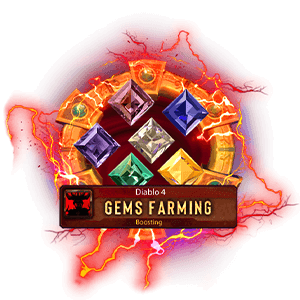
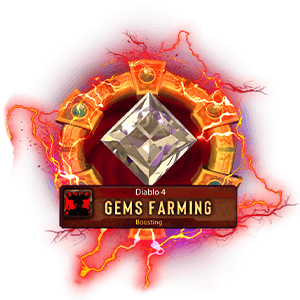
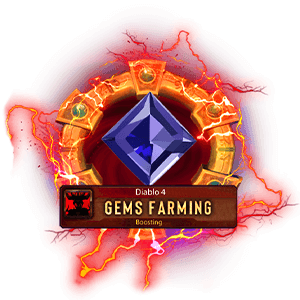
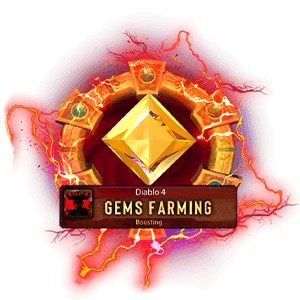
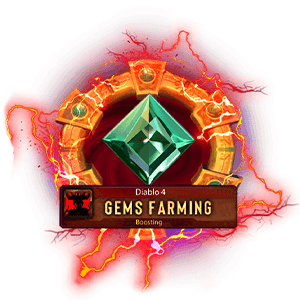
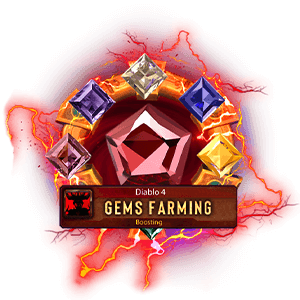
-
-
Select Platform:
Select Gem Quality:
Gem Quantity:
Gem Quantity:
-
Additional Options:
-
-
$1
Our Reviews
The service was great and the time it…
The service was great and the time it took was short. However, boosters need to be...
Ricardo Perez,
1 day ago
Excellent customer service
Excellent customer service. Prior to ordering I had a few questions. Response to my questions was...
Bonka Long,
1 day ago
Amazing as always
Amazing as always
customer,
3 days ago
Trust worthy!
Everything was done great and so quick! Got some amazing gear for such an amazing price!
Robert Worthy,
4 days ago
Quick service
Quick service
Alverzs,
5 days ago
Very good communication and fast and…
Very good communication and fast and efficient boost delivery.
Ivan P,
6 days ago
Raid Order Completion
Quick completion of Raid Order.
Lane Kramer,
7 days ago
Totally worth it
Got super lucky on drops and got a few pieces that are best In slot. Group...
sage me,
1 week ago
Quick and trustworthy thanks team
Quick and trustworthy thanks team
Luca Tarchi,
1 week ago
Stand behind their services
Always quick to put any of their services into action with minimal delay. They stand behind...
Gary Plain,
1 week ago
It was done quickly and they…
It was done quickly and they recommended this service to help facilitate my other orders
Pedro Martinez,
1 week ago
Amazing
This is an updated review. They completed my order in less than a day! Their boosters...
JonSkiieZ,
1 week ago
Quick and efficient delivery
Quick and efficient delivery. Currently using again
Mage,
1 week ago
Excellent work
Excellent work
M.S. B. Kurmo,
1 week ago
Reliable, fast and friendly!
Was contemplating to get a booster for my COD BO6 Camos but decided to pull the...
JonSkiieZ,
1 week ago
Excellent work
Excellent work, even or rather without my interference
M.S. B. Kurmo,
2 weeks ago
I stuffed up my order but Epiccarry…
I stuffed up my order but Epiccarry went out of their way to help me out,...
Greg,
2 weeks ago
Really good comunication and fast…
Really good comunication and fast service
Arturoaol.com,
2 weeks ago
Black Friday Deal
Awesome discount to get cosmetics that would otherwise be annoying to get on my own. Thanks...
Chris Isorena,
2 weeks ago
fast and efficient
fast and efficienthassle free, things ran well and on time
kenneth,
3 weeks ago
Rated 4.9 / 5 based on more than 6000 reviews. Showing our 4 & 5 star reviews.



